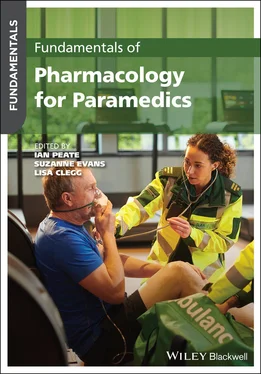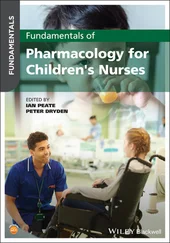1 ...8 9 10 12 13 14 ...21 With the huge range of drugs currently licensed for use, there are often multiple individual drugs available for any particular indication, so it is important that we also classify our drugs to make talking about them easier. We can classify drugs based on their chemical structures, mechanism of action or broader area of therapeutic use. The functional classifications (those relating to what the drugs do or what they are used for) are the most widely used, as they reflect the clinical uses of the drugs, but we often refer to certain groups of drugs by their chemical classification, as usually all agents belonging to a certain chemical class also have a predictable effect on function. Table 1.1gives some examples of the ways in which drugs are named and categorised.
Look‐alikes and sound‐alikes
Mistaking one medication for another because the two names (either generic or trade names) sound alike or the packages look alike is a common cause of medication error. Errors due to look‐alike sound‐alike (LASA) medications have become so widespread that the World Health Organization launched a worldwide effort to reduce medication errors that come about in this way (WHO, 2007), and many governments have made changes to their medication labelling and naming The addition of ‘tall man’ writing in the name of a drug has been introduced in the UK, Canada, Australia and the US to make the differences between drug names clearer. This technique involves capitalising the parts of the name that are most likely to be misread, for example:
AmiloRIDE, AmlodiPINE, BuPROPion, BupreNORphine.
The mix of capitalised lettering in the name disrupts rapid reading and forces a more careful observation of the name.
The main element in reducing medication errors, however, continues to be careful cross‐checking of LASA medications prior to administration, and ensuring that look‐alike medications are not stored in close proximity to each other. Because the packaging and appearance of medications can change, the generic name of the medication should always be checked, and the identity of a medication should never be assumed from its appearance without checking the label. For example, a 500 mL or 1000 mL bag of clear fluid could be Hartmann solution, sodium chloride or glucose 10%.
Table 1.1 Categorisation of drugs based on clinical usage, general action or specific mechanism of action.
| Generic name |
Trade names |
Chemical class |
Therapeutic use |
General action |
Specific mechanism of action |
| Diazepam |
Valium ®Valpam ®Antenex ® |
Benzodiazepines |
Anxiolytics |
Central nervous system depressants |
GABA agonists |
| Atorvastatin |
Lipitor ®Torvastat ® |
Statins |
Cholesterol synthesis inhibition |
Lipid‐lowering agents |
HMG Co‐A reductase inhibitors |
| Candesartan |
Candesan ®Adesan ®Atacand ® |
‐ |
Antihypertensives |
Blood pressure‐lowering agents |
Angiotensin receptor antagonists |
| Salmeterol |
Serevent ® |
‐ |
Acute asthma control |
Bronchodilators |
Long‐acting beta‐2 agonists |
| Diclofenac |
Voltaren ®Voltarol ®Difenac ®Clonac ® |
|
Analgesic, anti‐inflammatory |
Non‐steroidal anti‐inflammatories |
Cyclo‐oxygenase inhibitors |
GABA, gamma‐aminobutyric acid; HMG‐CoA, 3‐hydroxy‐3‐methylglutaryl coenzyme A.
How drugs bring about their actions
With only one or two exceptions (such as drugs which absorb other substances, e.g. charcoal or resins), drugs act by binding chemically to specific binding sites. It is this fact which explains the various observed characteristics of a drug, for example, the relationship between the shape of a drug molecule and its actions; the relationship between how readily it binds to its site of action and the concentration of drug needed at the site of action to bring about a therapeutic effect; the relationship between the number of different binding sites the drug can bind to and the number of different effects it produces; the strength with which it binds to the site and length of time for which it exerts its effects, and so on.
The site at which a drug binds to have its effects is known as the receptor for that drug, and it may be a receptor normally used by endogenous signalling molecules, such as hormones or neurotransmitters, or a binding site on an enzyme, ion channel or transport molecule. A substance binding at any of these sites would be able to alter physiological function when the structure to which the drug is binding is itself responsible for producing various physiological changes.
How are we able to manipulate physiological function using drugs?
Physiological systems make use of hundreds of specific signalling chemicals to carry out their own signalling function and this provides an opportunity to use drugs to mimic or block the effects that those endogenous signalling chemicals would produce. By employing drugs with chemical structures similar to those of endogenous chemicals, we gain an opportunity to ‘operate the levers’ of the human machine. Not surprisingly, therefore, the vast majority of the drugs used act by altering the function of one of these key pieces of signalling and transport machinery:
Receptors
Enzymes
Ion channels
Transport molecules
Drugs used as therapeutic agents act by manipulating physiological mechanisms, which reinforces the importance of having an understanding of human physiological responses as the basis for understanding pharmacology. Without a sound knowledge and understanding of how physiological systems respond, it is impossible to make sense of how drugs will interact with those systems.
Receptors as sites of drug action
An opioid drug such as morphine acts by binding to the receptors for endogenous opioids and, by activation of those receptors, produces similar actions to those generated by the endogenous opioids, including analgesia and a range of other effects. Similarly, bronchodilator drugs such as terbutaline and salbutamol, used during an episode of acute asthma, produce their bronchodilator effect by activating adrenergic beta receptors on the airways. These receptors would be activated physiologically by adrenaline and noradrenaline secreted during the fight or flight response, and the binding of adrenaline or noradrenaline to the beta receptors in the airways would produce a dilation of the airways, allowing a more rapid ventilation of the lungs. A drug which is able to produce this effect without producing the rest of the fight or flight response is a very useful therapeutic agent during an episode of acute asthma ( Figure 1.1).
Enzymes as sites of drug action
Enzymes are the large proteins that catalyse the thousands of biochemical reactions that maintain physiological function. An enzyme carries out the catalysis (speeding up) of a particular reaction by binding the reacting molecules and making it ‘easier’ for the reaction to occur ( Figure 1.2). Drugs which have enzymes as their targets tend to be inhibitors of those enzymes, preventing the normal reacting substances from binding with the enzyme for catalysis.
Drugs such as non‐steroidal anti‐inflammatory drugs (NSAIDs), the prototype of which is aspirin, act by inhibiting the enzyme cyclo‐oxygenase, which is responsible for speeding up the reaction producing a range of important signalling molecules known as prostaglandins. It is the reduced level of prostaglandins as a result of blockade of cyclo‐oxygenase that produces the range of effects associated with NSAIDs. Another example of a widely used class of drugs which act by blocking an enzyme is the statin class, including atorvastatin and fluvastatin. These drugs lower cholesterol levels by inhibiting the enzyme HMG‐CoA reductase, responsible for the production of cholesterol in living cells.
Читать дальше












